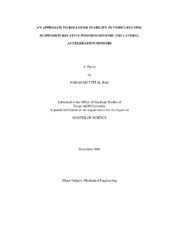| dc.contributor.advisor | Langari, Reza | |
| dc.creator | Vittal Rao, Narahari | |
| dc.date.accessioned | 2006-04-12T16:01:54Z | |
| dc.date.available | 2006-04-12T16:01:54Z | |
| dc.date.created | 2005-12 | |
| dc.date.issued | 2006-04-12 | |
| dc.identifier.uri | https://hdl.handle.net/1969.1/3071 | |
| dc.description.abstract | Safety in automobiles is gaining increasing importance. With the increasing trend of
U.S. buyers towards SUVs, appropriate safety measures for SUVs need to be
implemented. Since SUVs, as a vehicle type, have a higher center of gravity and hence
have a greater tendency to rollover at high cornering speeds. The rollover can also occur
due to the vertical road inputs like bumps and potholes which induce a rolling moment.
The proposed rollover identification system would "couple" the two inputs from the
suspension relative position sensors and the lateral acceleration sensor to predict
rollover. The input to the suspension relative position sensors could be either due to the
vehicle cornering, which results in the outer suspension getting compressed and the
inner suspension getting extended, or maybe due to vertical road inputs. The principal
objective is to differentiate the two types of inputs (since they can have opposing
moment values) and further couple the same with the lateral acceleration input to form a
rollover identification system.
The work involves modeling of a semi-car model using the Dymola-vehicle dynamics
simulation software. The semi-car model is developed to simulate values for the two
proposed sensors. Then using NHTSA standard steering procedures and steering angle
as the input, the lateral tire forces are generated. These tire forces serve as input to the
Dymola model which is integrated into a Simulink model. The lateral acceleration and suspension relative position sensor values obtained are then used by LabVIEW to pass
judgments on the type of rollover.
The model was successfully developed in Dymola. The model with steering angle as
input was able to generate values of lateral acceleration and lateral tire forces. The roll
angle induced due to road inputs and vehicle cornering were estimated. Since the
principal objective of modeling was to generate lateral acceleration values, these values
were subsequently used in the LabVIEW Rollover Identification System where rollover
induced either by maneuver or through road inputs were clearly identified. | en |
| dc.format.extent | 1275577 bytes | en |
| dc.format.medium | electronic | en |
| dc.format.mimetype | application/pdf | |
| dc.language.iso | en_US | |
| dc.publisher | Texas A&M University | |
| dc.subject | Rollover in vehicles | en |
| dc.subject | Lateral Acceleration Sensors | en |
| dc.title | An approach to rollover stability in vehicles using suspension relative position sensors and lateral acceleration sensors | en |
| dc.type | Book | en |
| dc.type | Thesis | en |
| thesis.degree.department | Mechanical Engineering | en |
| thesis.degree.discipline | Mechanical Engineering | en |
| thesis.degree.grantor | Texas A&M University | en |
| thesis.degree.name | Master of Science | en |
| thesis.degree.level | Masters | en |
| dc.contributor.committeeMember | Bhattacharyya, Shankar | |
| dc.contributor.committeeMember | Swaroop, Darbha | |
| dc.type.genre | Electronic Thesis | en |
| dc.type.material | text | en |
| dc.format.digitalOrigin | born digital | en |


